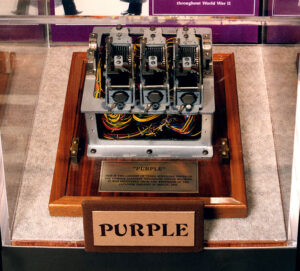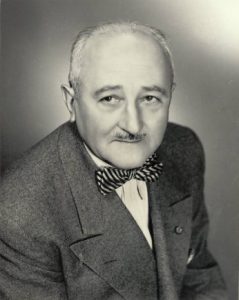 PURPLE, the name given to the Japanese diplomatic cipher system used during World War II, is not as well-known as the ENIGMA system used by the Germans but was considered the most complex cipher system of its time. Despite its complexity, a team of U.S. codebreakers led by William F. Friedman produced their first deciphered PURPLE message 76 years ago on September 25, 1940.
PURPLE, the name given to the Japanese diplomatic cipher system used during World War II, is not as well-known as the ENIGMA system used by the Germans but was considered the most complex cipher system of its time. Despite its complexity, a team of U.S. codebreakers led by William F. Friedman produced their first deciphered PURPLE message 76 years ago on September 25, 1940.
The interception of PURPLE messages by the Signals Intelligence Service (SIS), the codebreaking unit of the United States Army, began in 1937. Progress towards breaking PURPLE was so slow that in 1939 the additional codebreaking responsibilities of Friedman and his team were reassigned. Breaking PURPLE was the army’s top priority.
Without any distractions Friedman and his team approached the PURPLE cipher with renewed vigor. They used partially deciphered messages to test different approaches for converting enciphered messages into plain text. The first major breakthrough did not occur until August 1940 when the question of whether the PURPLE cipher machine used a device other than a rotor for enciphering text was raised. Friedman immediately adopted this theory and within a few days his team produced a number of partial solutions for the enciphering process. This new revelation enabled Friedman’s team to construct its own PURPLE cipher machine, so that by November 1940 the SIS could consistently produce deciphered messages from PURPLE intercepts.
 Although the PURPLE cipher system had been broken, the United States was unable to read every message sent using PURPLE. Messages intercepted in Hawaii were only sent to Washington, DC weekly, there were always many more messages intercepted than the SIS had cryptanalysts to decipher, and once messages were deciphered they still had to be translated from Japanese. The desire of the United States to keep the breaking of PURPLE a secret resulted in the deciphered messages only being shared with high-ranking officials who decided whether the information should be distributed.
Although the PURPLE cipher system had been broken, the United States was unable to read every message sent using PURPLE. Messages intercepted in Hawaii were only sent to Washington, DC weekly, there were always many more messages intercepted than the SIS had cryptanalysts to decipher, and once messages were deciphered they still had to be translated from Japanese. The desire of the United States to keep the breaking of PURPLE a secret resulted in the deciphered messages only being shared with high-ranking officials who decided whether the information should be distributed.
Despite the many challenges involved with breaking PURPLE and utilizing its valuable information, the work of Friedman and his team provided the United States with a significant advantage during World War II. Information obtained from PURPLE messages helped the navy achieve victory at the Battle of Midway, and the army to shoot down an airplane carrying Admiral Yamamoto Isoruku. General George C. Marshall recognized that being able to decipher PURPLE messages would, “contribute greatly to the victory and tremendously to the saving of American lives, both in the conduct of current operations and in looking towards the early termination of the war.”
The George C. Marshall Research Library and Archives holds the Papers of William F. Friedman, which are open for use by individuals interested in learning more about William F. Friedman and his involvement in breaking the Japanese PURPLE cipher system. For questions about William F. Friedman, his collection, or to schedule a research appointment please contact the research library staff.
